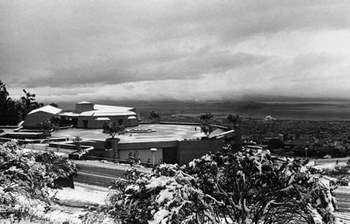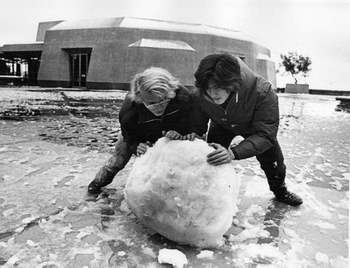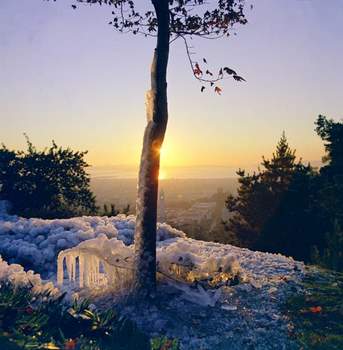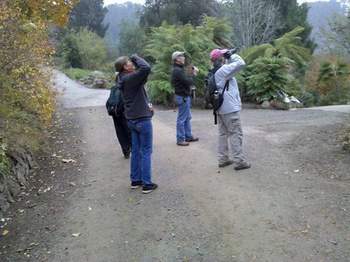A Busy Two Weeks
REMEMBERING ANOTHER WINTER
December 1972 began as an unexceptional month, although somewhat rainier than usual. At the end of the first week a light snow fell – unusual but not rare.


Lawrence Hall of Science in snow
The snow melted quickly as it usually does in Berkeley. But instead of returning to the normal weather pattern for the month, the cold deepened.
Memory has a way of making droughts deeper, rains more torrential, and heat more intense. But this iron-fisted cold, which has persisted in the memory of those who were here, was truly cold. Nights around the Bay Area were well below freezing, averaging between 23-28 degrees F. During the day, the thermometer struggled to reach 40 degrees. Worse, the cold continued for a week.
In StrawberryCanyon, it was even colder. For two nights in a row the temperature plunged to 14 degrees and stayed below freezing even during the day. At the UC Botanical Garden, 1500 plant species were killed. The African collection, especially the areas known as African Hill and the New WorldDesert which share the same slope, were the hardest hit. The cold even reached into downtown Berkeley where all the ficus, planted as street trees on Telegraph Avenue, were frozen
The neighbors north of Lawrence Hall of Science watched helpless as their gardens died. Vines released their grip and turned brown. Succulents drooped and as their cells burst, dissolved into a black mush. Important landscape hedges were frozen. Only the hardiest plants like the conifers survived. One gardener, hoping to save his garden ran his sprinklers, turning his garden into a complex ice sculpture, until the water froze in the hoses. Many people had no water at all when their pipes froze and broke. Ice-covered driveways trapped cars in their garages.
Anna’s Hummingbirds, our one year-round hummer, deprived of the flower nectar to fuel their constant need for food, were found comatose. People put out hummingbird feeders, but the sugar water had to be frequently thawed.
And what became known as the Big Freeze of 1972, transformed the hillside landscape when between two to three million blue gum and river red gum eucalyptus froze to the ground. Though many of the trees had survived and later sprouted from their stumps, the dead growth above ground had to be cut and removed ahead of the summer and fall fire season. Local emergency rooms treated an unusual number of broken bones as home owners tried to cut down their own trees. Lawrence Hall of Science and the Space Sciences building lost their green surround.

Lawrence Berkeley Laboratory near the cafeteria, December 1972
After that punishing December, the Botanical Garden planted fewer frost-sensitive plants. But after a few years, hillside gardeners with shorter memories once again planted trumpet vines, bougainvillea, and citrus. This December when the thermometer dropped briefly below freezing on two mornings, only the most tender plants were nipped.
THE ANNUAL AUDUBON CHRISTMAS BIRD COUNT
This year the Oakland count day fell on Sunday, December 20. The weather was pleasant allowing the 200 participants a good day in the field. The first Oakland count in 1938 drew three participants. Now, 29 teams, two on boats in the Bay, fan out over the count circle which is centered at LakeMerritt in Oakland. The circle takes in Alameda, Albany, Berkeley, Emeryville, most of the new EastshoreState Park, and over the hill to include parts of Lafayette, Moraga, and Orinda. The wide variety of habitat yields up around 173 species.
Lillian Fujii and her husband Steve Hayashi, lead the team which includes the UC Berkeley campus, StrawberryCanyon and the surrounding hills (including LHS on the northern edge). Though final totals aren’t yet in, the StrawberryCanyon team counted seven California Thrashers, one of the Botanical Garden favorites.

UC Botanical Garden – Christmas Bird Count 2009
The count day ends with a count dinner with expert birders and experienced compilers Bob Lewis and Dave Quady presiding. “The Bob and Dave Team” provided plenty of merriment along with the serious business of recording the sightings. Six-year-old Laz, the youngest participant, began his day at 4:30 am on Dave’s owling team. The “best bird” prize went to the KnowlandPark team who saw the rare (for this area) Gray Flycatcher.
Though the number of species has remained somewhat constant over the years, the number of individuals shows a long-term downward trend, even taking into account variations in the weather on count day and the number of people in the field.
Check out the local Golden Gate Audubon website (www.goldengateaudubon.org) for more information. The March issue of The Gull will include Dave Quady’s count report.
--Phila Rogers